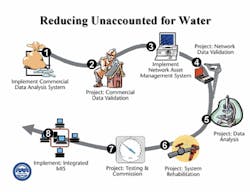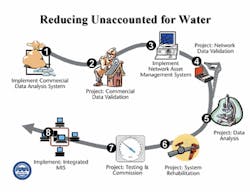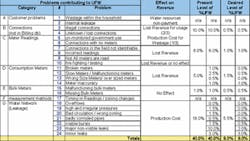UFW reduction requires system rehabilitation - not only leakage repairs
By Dr. Dinos Constantinides
Water utilities are coming under more pressure to operate with greater efficiency and profitability; however funding for network rehabilitation and upgrading is limited and funding applications are subject to far more scrutiny than before. In addition, the commercial aspects of expanding water treatment, supply and storage facilities to accommodate unaccounted for water (UFW) are no longer viable or acceptable and the wastage and loss of this scarce commodity carries a price tag that is generally borne by dissatisfied consumers.
UFW must be reduced to maximise the use of existing assets and improve the commercial operation and profitability of the utility, but the "old school" process of addressing the problem as a one-off project is ineffective since there is no sustained monitoring and controlling of the lowered levels of UFW.
Commercial and technical factors must be addressed simultaneously to develop a long-term dynamic business solution. This methodology involves the implementation of integrated information systems as a means of empowering a utility to improve its overall operational efficiency and profitability.
Table 1 goes into further detail to give estimates of present UFW levels at a typical water utility in addition to desired levels of UFW. The table shows the effect on revenues and costs to the utility for each UFW component. Of particular interest is the first group, titled "Customer Problems" which refers to water wasted after consumer metering. Although this wastage, strictly speaking, does not contribute to UFW, it should be noted that this type of wasted water often results in consumers not paying for services received, thereby creating an undesirable culture of non-payment.
The reduction of UFW lowers operating costs. The lifespan of current assets can be extended, and the capital requirements for increasing capacity of water treatment, conveyance and storage facilities can be postponed by eliminating factors that contribute to UFW. Conversely, by using current assets more effectively, the resulting additional capacity can be used to service additional customers, which reduces operating costs and increases revenue and profits.
More realistic tariffs can be applied by increasing profitability. This reduces the need to subsidise UFW and improves the level of service to consumers. The result is a win-win situation for consumers and supply organisations.
Appropriate software, accompanied by appropriate procedures and methodologies, can be used not only to efficiently run a water utility but also to solve major UFW problems. Software can quantify, narrow down, identify and finally eliminate in a progressive and organised manner all UFW components caused by leakage and other problems. Subsequently, such software can help to effectively monitor and restrict UFW to low levels. Integrated operational and management systems are needed for all core-business departments, ranging from the commercial, operations and maintenance, design and planning and corporate services-GIS department. Integration is of vital importance, as many problems require input and effort across departmental boundaries.
The proposed methodology adopts the approach of addressing UFW by systematically narrowing down the problem. The process begins with data collection, validation and analysis and culminates in leakage detection and rehabilitation.
A modern appropriate billing system should not only address billing, but should be geared towards problem solving by addressing customer services, meter reading operations, meter and connections management, data validation and debt management. Correct and reliable billing is one of the cornerstones of customer service and will increase levels of confidence and, ultimately, payment for services. The system should ideally be integrated with other facets of an organisation's business such as engineering, planning, GIS and operations, in order that these areas can also benefit from the use of consumption data for analysis and management purposes.
In the absence of such billing, and in the case of utilities not wishing to change their existing billing system, a commercial data analysis system should be implemented. This system must interface with the utility's billing system and must have the ability to import and export data to it. The commercial data analysis system is used to evaluate commercial data and relationships inherent in the billing system and facilitates field surveys to validate such data. Furthermore, the system should perform meter readings analysis that will identify and highlight suspect readings for exclusion from demand analysis calculations and should, ultimately, have the capability to prepare a meter replacement program based on various findings from the analysis.
The commercial data validation process should correctly correlate and validate the following commercial data: customers/properties, properties/plots, and properties/connections. The validation is achieved by collecting data from various sources, including field surveys, and comparing them with data in the billing system.
Resulting discrepancy reports are subsequently investigated in the field and corrected. This exercise not only rectifies problematic data in the system, but also identifies illegal connections and prospective customers. Addressing these factors has a marked effect on increasing revenue.
Understanding one's water network is extremely important before attempting to carry out any remedial work.
During this stage, an appropriate Network Asset Management system must be implemented using appropriate Geographical Information Systems (GIS) and all network assets data must be converted and/or captured into the system. The network should also be automatically manipulated by the system to indicate discreet zones for accurate water balancing, pressure control and maintenance. Implementing these methodologies will provide engineers with a better understanding of the behaviour of the existing network and highlight anomalies and problems.
Maps with marked queries are prepared using the system data captured in the previous stage and are used by experts in the field to carry out network inspections for validating captured network data. Manual inspections include walkthrough routes using equipment such as metal detectors, cover locators, pipe and cable locators, water pipe locators, measuring wheels and listening sticks to carry out the following tasks —
• Record all visible leaks;
• Isolate valves;
• Record hydrant information;
• Record all chambers, pipes, bulk meters, pressure readings;
• Sounding of valves and pipes using electronic amplified equipment to localise leak areas.
By this stage, the billing system should reveal accurate consumer and consumption data for precise geographical locations that can be applied to the network. Similarly, the network data should be much more accurate. To gain an even greater understanding of system behaviour, additional studies and analyses are conducted. These include zoning, setting demand management model, demand analysis, network analysis and rehabilitation programs.
System rehabilitation is carried out, either directly by the utility for small activities or by hiring suitable contractors, through the following programs -
• connection and consumption meters rehabilitation;
• network rehabilitation (stage one), fixing visible leaks, isolating valve and hydrant rehabilitation and remedial pipe work to achieve zoning;
• network rehabilitation (stage two), involves supply and installation of bulk supply meters, pipe work for upgrading network, installation of pressure reducing valves and pressure breaking tanks to effect pressure zoning.
Leakage is only included at this stage of the project and not earlier because it is considered unadvisable to conduct leakage detection unless basic zoning and pressure problems have been rectified in each district.
Summary
This methodology efficiently identifies, localises and reduces UFW, maximizing use of existing assets and increasing revenue. Information technology is used to efficiently address UFW whilst equipping the organisation with operational tools to monitor and control UFW in a continuous and sustainable manner.
Operational aspects and efficiencies in addition to UFW must be addressed to develop a viable and profitable water utility. The traditional approach of addressing UFW through leakage detection is seen as part of a process, rather than a self-contained exercise. The methodology adopted here argues that for any meaningful, cost-effective and lasting leakage detection and repairs to be carried out, such work must be preceded by system rehabilitation. Such work should be carried out as the last step of the implementation methodology.
Author's note
Dr. Dinos Constantinides works for Edams Technology, which is based in Cyprus. EDAMS Technology is the research and development division of Hydro-Comp Enterprises Ltd.


